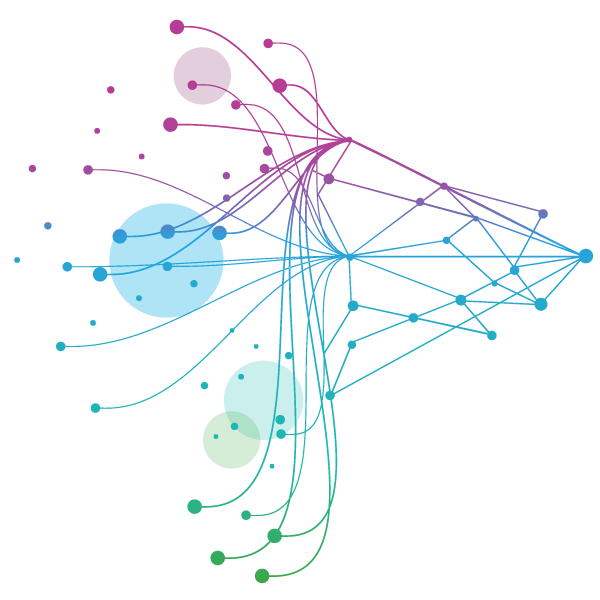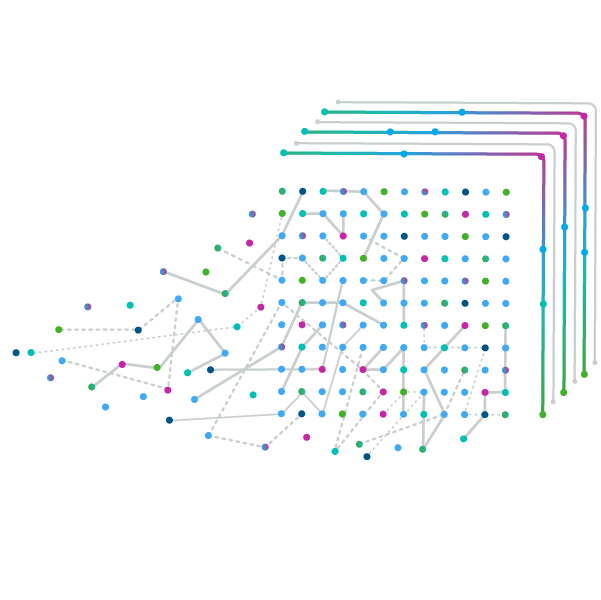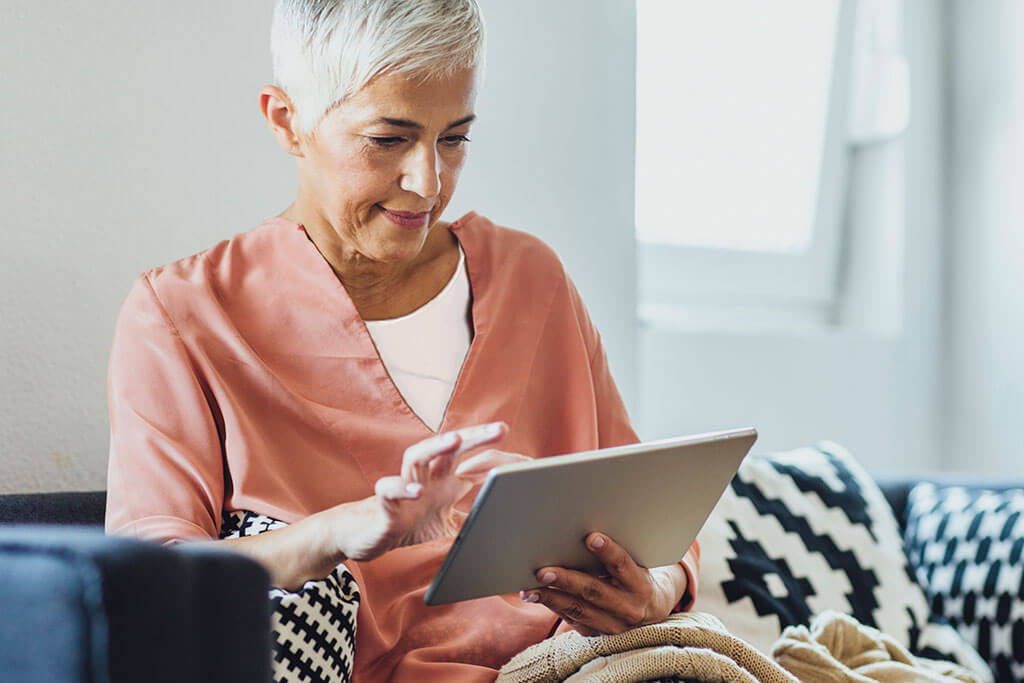Discover new approaches to cardiovascular clinical trials to bring game-changing therapies to patients faster.
Introduction
Novel anti-obesity medicines (AOMs) are revolutionising the market and bringing obesity as a therapy area to the fore. However, they are not the only thing transforming the management of obesity. Alongside them, a vast number of digital solutions are supporting weight management in more sophisticated ways. For example, over-the-counter continuous glucose monitors (CGMs) are booming in popularity with curious consumers who want to monitor their blood sugar responses, wearables and smartphones are providing fine-grained remote monitoring (even giving digital nudges to support with sustained behavioural changes) and consumer apps for obesity and weight management are gaining significant use, with around 1.5 million installs on average1. This article will explore how digital solutions are revolutionising the management of obesity for patients and healthcare systems, and what this means for the pharmaceutical companies behind new transformative pharmacological anti-obesity agents.
Digital solutions for weight management
The term ‘digital solutions’ is broad and can be categorised in many ways, for example: what the digital solution is (e.g. software such as mobile apps, or measurement tools that analyse signals from biosensors); who it is for (e.g. patient, provider); or intended purpose (e.g. general wellness, disease diagnosis, disease management, monitoring or treatment)1. Figure 1 shows some key examples of the types of digital solutions currently being used for weight management, including the top-rated apps for weight disorders according to IQVIA’s AppScript Digital Medicine Database, and insights from in-depth interviews that IQVIA has conducted with people living with obesity in the US, UK and Spain on how digital solutions are currently being used (IQVIA’s Obesity Patient Voice Book of Insights2).

Some digital solutions have been supporting weight management for decades. For example, MyFitnessPal (which offers comprehensive dietary tracking), activity trackers such as Fitbit, and Noom (a psychology-based mobile app providing personalised coaching) have all been around since the noughties. However, the rise of novel anti-obesity agents will transform the role and importance of digital solutions; for example, by raising new questions on how to optimise, manage and deliver care for the millions of patients that could benefit, prove cost-effectiveness and population outcomes for new treatments, and fill the gaps and unmet needs of patients that cannot be addressed by pharmacological therapies alone. Recent analysis in mid-2024 found that apps for obesity and weight management now have around 1.5 million Google Play installs on average, far more than the average for other therapy areas (mental and behavioural disorders take second place with an average of 300 thousand installs per app, although ‘total installs’ for mental health apps are higher)1. In addition, in 2024 the FDA approved multiple over-the-counter CGMs such as Abbott’s Lingo and Dexcom’s Stelo in the US, which are now being used by curious consumers who want to understand how food and other lifestyle changes like exercise and sleep can impact glucose levels/spikes3. Here, we explore the evolving role of digital solutions in addressing unmet needs in obesity.
Addressing patient unmet needs that cannot be addressed with pharmacological agents
As we have previously outlined in other blogs, obesity is a complex, multi-faceted condition: patients with weight disorders typically suffer psychologically and emotionally, including with severe mental health challenges4, and frequently present with multiple other co-morbidities such as diabetes, kidney disease and hypertension5. IQVIA conducted in-depth interviews with people living with obesity to understand their most important unmet needs. These highlighted how important psychological and emotional support is for patients living with obesity, and that patients require a holistic approach to care in order to make lasting behavioural challenges (figure 2).

Digital health solutions can address many of these unmet needs in a structured, scalable and cost-effective way. For example, they can provide social and community support, ‘mass-personalised’ online coaching and behavioural support, and improve access to key support services (such as cognitive behavioural therapy) and multi-disciplinary teams, including professionals such as nutritionists, therapists or physiotherapists. The HTA body in the UK, NICE, has recommended four digital weight management programmes (Liva, Oviva, Roczen and Second Nature) to help the NHS deliver weight management services, and has calculated that up to 48,000 people would be able to access the virtual services, and up to 145,000 hours of clinician time could be saved6.
Improving access to, and enhancing persistence and outcomes of, pharmacological treatments
Obesity could affect 25% of the global population in a decade7, and while new anti-obesity medications hold great promise, there are considerable concerns about both equity of access, and potential spend. Certainly, optimising outcomes on anti-obesity medicines will be critical. Digital solutions can simplify the process of obtaining necessary medications, thus reducing economic and logistical hurdles.
In addition, they can provide medication support, including medication reminders, which can play a crucial role in improving patient adherence and persistence, and therefore enhance the impact of pharmacological interventions. This will be critical, as Canadian data for some GLP-1 agents including Ozempic (in patients without a history of diabetes) and Saxenda shows that less than one third of patients remained on therapy after a year, suggesting that persistence might be a major challenge for anti-obesity agents8. Robust persistence data for Wegovy and Mounjaro/Zepbound will not be available for some time due to product shortages caused by the overwhelming demand for these agents.
Data collection
More patients than ever are empowered to leverage digital devices to optimise their health and tackle healthcare challenges, meaning digital devices are collecting a growing amount of data related to patients’ health indicators and daily activities. Wearable technology has become an invaluable tool in health monitoring, offering a wealth of patient-generated data including vital signs, activity levels, and even sleep patterns, providing continuous, real-world evidence of health outcomes. This data can be aggregated and analysed to demonstrate improvements in weight, blood sugar levels, blood pressure, and other health metrics, which may prove critical in demonstrating the efficacy of anti-obesity treatments to health systems and payers. This can strengthen the case for the cost-effectiveness of treatments, thereby supporting favourable pricing and reimbursement policies.
Moreover, this data can help healthcare providers personalise treatment plans, identify early signs of potential complications, and adjust interventions in real-time, leading to better health outcomes and patient satisfaction.
Importantly, in-depth interviews with obesity patients suggest they are open and willing to share data (as multiple parameters are already being tracked both by patients themselves via wearable devices and by their HCPs), and provide important insights on prerequisites and parameters for sharing data; for example, some patients want data to be shared back and discussed with them (figure 3).

What does this mean for pharma?
Digital solutions can clearly support patients, healthcare systems, and payers to better manage obesity. Therefore, pharma companies developing anti-obesity drugs need to view digital as a critical success factor in the space, but will need to consider some key strategic questions:
- What are the best-in-class digital solutions and best potential partnerships? Partnerships in digital health, digital therapeutics and digital patient support solutions will be key to unlocking digital potential. For example, Novo Nordisk has formed multiple partnerships, including with the weight-loss app Noom in 2019 (after a pilot found that patients enrolled in the SaxendaCare patient support programme gained significant value from the combined offering)9, and partnerships with multiple glucose monitoring companies, currently focused on improving diabetes management. To partner effectively, pharma companies will need to develop a robust understanding of the critical success factors for digital solutions and identify best-in-class digital products that are user-centric and evidence-based. Indeed, Noom was one of the top four weight management apps rated by IQVIA’s AppScript Digital Medicine Database (which assigns scores based on quality indicators in six categories: clinical, professional, patient, functional, endorsement and developer). Best-in-class digital patient support tools will be a key strategic differentiator in an increasingly crowded obesity landscape.
- How should pharma work with digital solutions when introducing anti-obesity medications? Lilly (the manufacturer of tirzepatide [Mounjaro/Zepbound]) has set up a different kind of digital solution to support people with obesity in getting access to AOMs. In the US, where direct to consumer advertising is allowed, the company has set up LillyDirect, an online pharmacy and virtual care service providing patients with a way to be prescribed Lilly medications and get them delivered to their homes. DTC is prohibited in Europe, but in all geographies pharma should consider partnerships with digital health weight loss solutions and telehealth providers that can help to ensure access to AOMs.
- How can pharma best leverage patient-mediated data for ongoing RWE generation, and to optimise patient outcomes? The future will include leveraging patient-mediated data through digital companion solutions and CGM devices, in order to demonstrate population outcomes (such as a reduction in comorbidities and increased economic productivity), and support better patient outcomes through more tailored and personalised care. Crucial for this will be the ability to seamlessly integrate and incorporate data from multiple sources such as wearables, medical devices and self-reported information. In-depth interviews confirm that whilst people living with obesity are willing to share passively collected information (e.g. from wearables), they want to have a clear understanding of the benefits to their own health and overall research in order to be willing to actively provide information (such as self-reported food diaries), which require considerable time and effort2.
Digital solutions are already transforming the management of obesity, and crucially, they offer significant opportunities for pharmaceutical companies to increase the value proposition of their AOMs to patients, health systems and payers. Leveraging best-in-class digital solutions and partnerships will be a key strategic lever to differentiate and optimise patient outcomes.
References
1 Digital Health Trends 2024; IQVIA Institute report, December 2024: https://www.iqvia.com/insights/the-iqvia-institute/reports-and-publications/reports/digital-health-trends-2024
2 Obesity Patient Voice Book of Insights: Leveraging IQVIA - Obesity Action collaboration
3 FDA, March 2024: https://www.fda.gov/news-events/press-announcements/fda-clears-first-over-counter-continuous-glucose-monitor; Abbott, Jun 2024: https://www.abbott.com/corpnewsroom/products-and-innovation/hello-lingo-next-gen-health-coach-is-fda-cleared.html
4 In-depth patient insights in obesity highlight the need for a holistic, individualised approach to therapy; IQVIA blog, November 2024: https://www.iqvia.com/locations/emea/blogs/2024/11/in-depth-patient-insights-in-obesity-highlight
5 When the dust settles: The future shape of the obesity market; IQVIA blog, May 2024: https://www.iqvia.com/locations/emea/blogs/2024/10/when-the-dust-settles
6 NICE; August 2023: https://www.nice.org.uk/news/articles/digital-services-to-enable-easier-access-to-weight-management-support; Pharmaphorum article, August 2023: https://pharmaphorum.com/news/four-digital-weight-loss-programmes-get-nice-support
7 2024: The obesity market’s inflection point?; IQVIA blog, February 2024: https://www.iqvia.com/locations/emea/blogs/2024/10/2024-the-obesity-markets-inflection-point
8 IQVIA Rx Dynamics® pharmacy prescription data (LRx), Canada, May 2023-April 2024; Achieving Launch Excellence within the Obesity Market
9 FiercePharma article, October 2019: https://www.fiercepharma.com/marketing/novo-nordisk-teams-trending-weight-loss-app-noom-to-help-patients-obesity

























